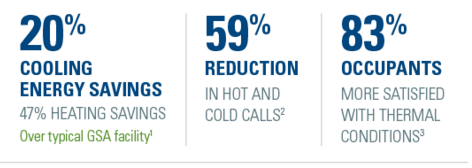Social temperature control pilot improves comfort, saves energy, shows where to use technology next
By Drew Jack
Most of us work in office buildings with centrally controlled heating, ventilation, and air conditioning (HVAC) systems. We are flanked in open-plan offices by co-workers with personal space heaters on one side and desk fans on the other. We have learned to dress in layers to come to work. If you are like me, you keep your puffy vest on all day and have no idea where the thermostat is. Could someone call building services?
Now a new technology that builds off of social and personal engagement may change all of that. It’s called socially driven HVAC.
Traditional HVAC systems maintain indoor air temperature within a set range, or “deadband.” A fixed deadband does not accommodate personal temperature preferences and leaves some of us feeling either too hot or too cold—especially since it doesn’t adjust for when you’re warmer after coming in from a brisk walk, or colder from forgetting your puffy vest at home. It can also waste energy by conditioning or heating air in unoccupied or occasionally occupied spaces.
Socially driven HVAC accepts direct input from office workers to address these problems. Using a website or app, any building occupant can request temperature adjustments to local office spaces and in response, the system delivers an immediate stream of warm or cool air. The system also tracks user preferences over time so that the deadband can be fine-tuned for our comfort and widened for greater energy savings when no one is requesting adjustments.
Recently, GSA’s Green Proving Ground (GPG) program and the Department of Energy’s Oak Ridge National Laboratory tested socially driven HVAC in the blazing heat of summer at our Federal Building and U.S. Courthouse in Phoenix using Oakland-based Building Robotics’ Comfy app.
The results of the pilot showed 20 percent cooling savings and a 59 percent reduction in hot and cold calls to building management. Building management staff calculated that we could save an estimated $6,700 in annual energy costs, not even accounting for the decreased use of space heaters and desk fans. The GPG report identifies the estimated energy savings per square foot for three standard building sizes in 16 different climate zones; i.e, the maximum break-even subscription cost of the technology, if based solely on energy savings. The report also found that 83 percent of occupants were more satisfied with their thermal conditions with the Comfy system, and that high user engagement has been maintained for the two years that the system has now been running.
management. Building management staff calculated that we could save an estimated $6,700 in annual energy costs, not even accounting for the decreased use of space heaters and desk fans. The GPG report identifies the estimated energy savings per square foot for three standard building sizes in 16 different climate zones; i.e, the maximum break-even subscription cost of the technology, if based solely on energy savings. The report also found that 83 percent of occupants were more satisfied with their thermal conditions with the Comfy system, and that high user engagement has been maintained for the two years that the system has now been running.
The GPG report concludes that socially driven HVAC optimization will be most effective in facilities with high energy costs, narrow deadbands that can be given room to swing, and a significant portion of space that is only intermittently occupied, or where tenant thermal comfort is a priority.
The GPG program leverages GSA’s real estate portfolio to evaluate innovative sustainable building technologies by performing real-world evaluations of technologies in their early commercial stages, to accelerate market uptake of those that prove to be efficient and cost-effective.
Reference above to any specific commercial product, process or service does not constitute or imply its endorsement, recommendation or favoring by the United States Government or any agency thereof.

 U.S. General Services Administration
U.S. General Services Administration